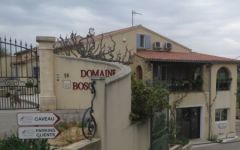Bosquet des Papes Chateauneuf-du-Pape Gloire de Mon Grand-Pere 2019
-
Jeb
Dunnuck -
Wine
Spectator -
Robert
Parker



Product Details
Your Rating
Somm Note
Winemaker Notes
Bosquet des Papes Chateauneuf-du-Pape Gloire de Mon Grand-Pere is a nice red color with shiny highlights. On the nose, this Chateauneuf-du-Pape spreads spiced aromas. It has a smooth and delicate mouthfeel.
This wine matches perfectly with game, grilled rib roasts, meats in sauce and cheese.
Professional Ratings
-
Jeb Dunnuck
Almost all Grenache, the 2019 Châteauneuf Du Pape A La Gloire De Mon Grand-Père comes from the La Gardiole lieu-dit and was aged 80% in demi-muids and 20% in foudre. Its deep purple/plum color is followed by a stunning array of black cherry, blackberry, and ripe strawberry fruits as well as candied flowers, orange blossom, and toasted spice. As with the old vine cuvée, the tannins have a firm edge and it's built with short-term cellaring in mind, yet the purity is brilliant, I love its balance, and this is just a stunning Grenache that's going to have two decades of pure pleasure giving.. Rating: 96+
-
Wine Spectator
This is packed, featuring juicy and energetic raspberry, blackberry and dark plum pate de fruit flavors wrapped in licorice root, black tea, singed juniper and incense notes. Everything knits tightly through the finish, with the underlying freshness extending to a lengthy finish as the juniper note leaves a mouthwatering echo. Serious, old school style.
-
Robert Parker's Wine Advocate
All Grenache, aged in a combination of demi-muids and foudre, the 2019 Châteauneuf du Pape A la Gloire de Mon Grand-Père delivers black cherries and blackberries, plus hints of clove, allspice and garrigue. Full-bodied, dense and rich, with plenty of alcohol ("but less than 16%," said Nicolas Boiron), it finishes long and velvety but also a bit warm. Best after 2023
Other Vintages
2018-
Robert
Parker -
Jeb
Dunnuck
-
Jeb
Dunnuck -
Robert
Parker -
Wine
Enthusiast -
Wine
Spectator
-
Robert
Parker -
Jeb
Dunnuck -
Wine
Spectator
-
Robert
Parker -
Wine
Spectator
-
Robert
Parker
-
Robert
Parker




Since 1860, this domaine has been handed over from father to son by the Boiron family. For five generations, the philosophy of “Bosquet des Papes” estate is to produce laying down wines, meaning that they can be kept for many years, thereby respecting the traditions of Châteauneuf-du-Pape wines. The domaine is now run by Nicolas Boiron and his wife Jeanne-Claire.
Most of the wooden vessels in the cellar are foudres but they are using more and more demi-muids maybe by influence of Philippe Cambie.
The domain covers about 40 different parcels, a total of 32 ha of which 3.5 ha are Cotes du Rhone. The average age of the vines is about 50 years. A 3.5 ha plot with vines aging around 100 years are used for Cuvée Chante le Merle.
